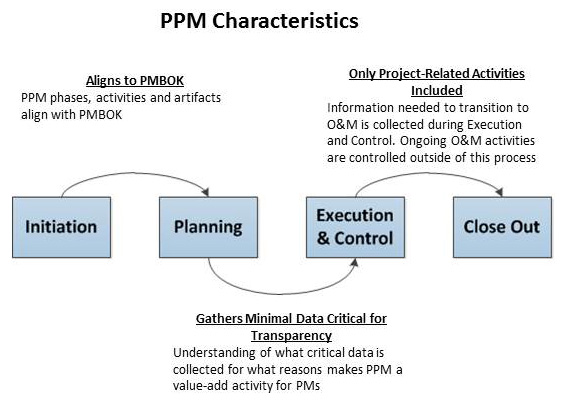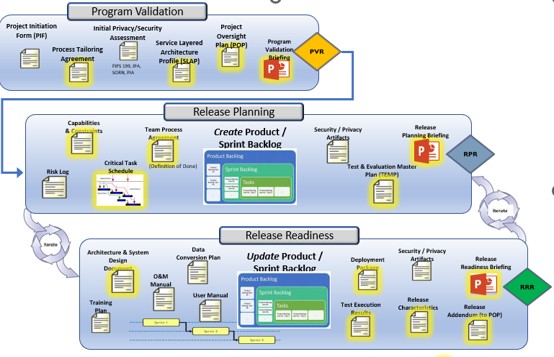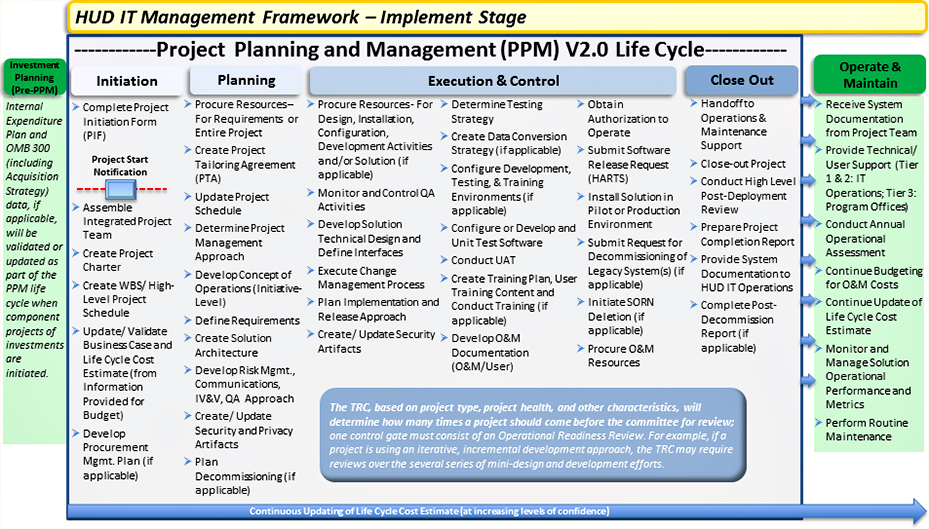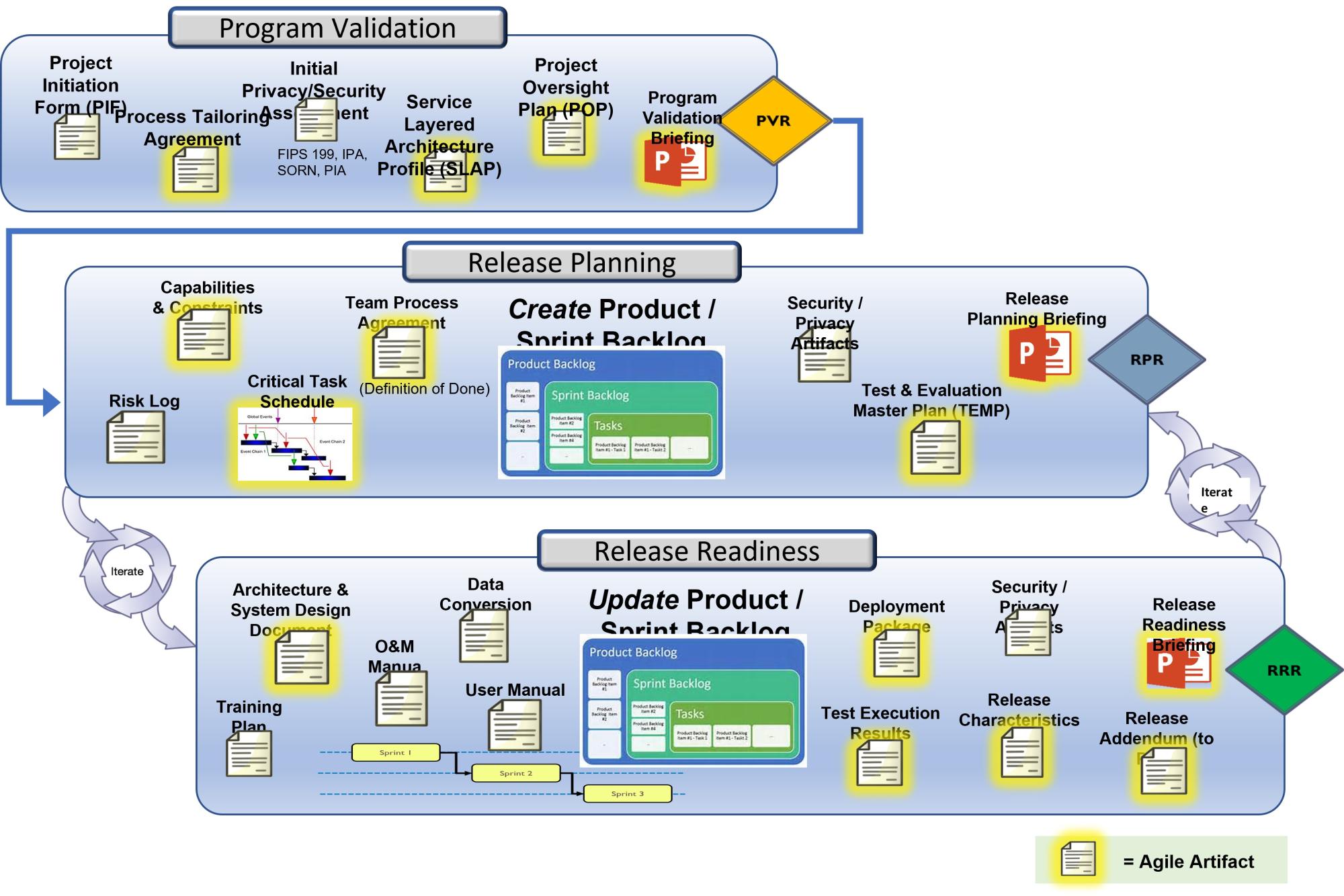Project Planning and Management V2.0
HUD now offers two primary paths for managing projects. The traditional PPM is Predictive Focused featuring a more plan-driven or linear approach. This approach is recommended when the requirements are fully understood and fixed; a lower frequency of delivery is desired; and a lower degree of change is expected. The product is delivered once at the end of the phased development cycle. This methodology favors process over innovation. Learn more about Traditional PPM.
The other path for managing projects is Agile PPM. All software development projects at HUD are required to use this approach. This methodology is Adaptive Focused and is geared toward constantly incorporating customer feedback and the continuous iteration of development and testing in the entire software development lifecycle of the project to deliver chunks of value in increments, or Agile Artifacts.
Learn more about Agile PPM and its tools. You can also read more about HUD's Agile Methodology policy.
If you have any questions related to PPM or Agile, please contact PPM@hud.gov.
| Traditional PPM | Agile PPM |
 |  |
Related Information
The matrix below outlines key activities within the four phases of the PPM V2.0 Life Cycle.
Below each phase heading are links to the phase-specific user guide.
The user guides provide a detailed description of the phase, identify key tasks and activities, and an overall phase process flow. They also provide guidance on project type differentiators, artifact consolidation at the program or initiative-level, and iterative development considerations for the phase. Template owner information and who should sign off on each artifact prior to control gate reviews is also given. To learn more about each phase, select the appropriate user guide.
Beneath the matrix is a link to a detailed graphic representing all elements of the PPM V2.0 Life Cycle.

Below is a link to a graphic of the full PPM V2.0 Life Cycle that includes pre-PPM activities and tasks, Operations and Maintenance key activities and tasks, and information on control gate reviews.
HUD information technology projects and infrastructure services are governed by the Technical Review Sub-Committee (TRC). The TRC's mission is to ensure that necessary PPM artifacts are produced in alignment with project and segment goals, and that PPM policy is followed. The TRC provides its analysis to the Chief Information Officer (CIO) and Customer Care Committee (CCC) which makes recommendations to the Executive Investment Board (EIB) for final decisions on project initiation or continuation.
1. Submission of Artifacts
a. Submission of PPM V2.0 Artifacts to the Technical Review Subcommittee (TRC) occurs at multiple points during the PPM V2.0 phases. Prior to submission of the artifacts, the IT Project Manager is accountable for obtaining signatures for each submitted artifact. The signature represents concurrence with the content within, prior to submission for the control gate review. Submission of artifacts occurs two weeks before the desired control gate review. The package of completed and signed PPM artifacts should be emailed to the TRC in preparation for control gate review at trc@hud.gov.
Select the link below for more detail on the artifact signature process, including who should sign off on each artifact before it is submitted.
PPM V2.0 Artifact Signature Process via esignature
PPM V2.0 Artifact Signature Matrix
2. Control Gate Review
a. The TRC acts as a control gate in the Project Planning and Management (PPM) Life Cycle to ensure that necessary deliverables are appropriately produced for project continuation.
The TRC holds meetings to conduct reviews of projects as needed. The TRC Secretary will notify both the project team and TRC members when a meeting has been setup.
Select the link below for more detailed information on how to request a control gate review and how control gate reviews are conducted. After the control gate review, the TRC Chair will provide a signature approving the reviewed artifacts after any edits are performed as a result of the control gate review meeting.
TRC PPM V2.0 Artifact Control Gate Review Process Flow
3. Authority
a. The TRC is established under the authority of the Clinger-Cohen Act ( PL 104-106 at 40 USC, Chapter 25), and functions under the provisions of the Office of Management and Budget (OMB) Circular A-130, revised. Functional oversight of the TRC is provided by the CIO, and the chair of the TRC is the Chief Technology Officer. The TRC has the authority to establish additional working groups to support its roles and responsibilities.
4. Membership
The TRC is composed of members representing key technical stakeholders within the OCIO. Membership of the TRC includes the following:
- Chief Technology Officer (TRC chair; votes in the event of tie)
- Chief Architect
- Chief Information Security Officer (CISO)
- Chief Privacy Officer
- Director, Network Administrator
- Director, Enterprise Program Management Division (EPMD)
- Investment Review Sub-Committee (IRC) Chair (Non-Voting)
Project Type guides provide overview information and guidance to project teams on specific project types. Each guide provides information on how to tailor the Project Planning and Management (PPM) Life Cycle to that specific project type, eliminating the time and resources project teams spend determining how to navigate PPM requirements.
Related tools such as the Project Tailoring Agreement, Work Breakdown Structure Example, and Project Schedule Template are pre-tailored to the project types which give each project a head start in finding out which artifacts need to be completed for a project.
Below are links to PPM V2.0 guides and tools for the most popular IT project types.
The matrix below depicts the PPM V2.0 artifacts and whether or not each is required, not required, or candidates for tailoring by project type. Artifacts are templates in which to document the work performed by the project team as it proceeds through the PPM Life Cycle and conducts the tasks and activities necessary to deliver an IT system or service.
For your convenience, the artifacts are provided in PDF and either Word, Excel or MS Project formats depending on the artifact.
In the Artifact column, hover over each title for a brief description of the artifact. To learn more about the submission process, use the PPM V2.0 Governance link under Related Information.
The IT PM's main responsibility is to ensure that all artifacts bear the minimum requested Approver signatures prescribed in the Artifact Signature Matrix. For greater security, the signature page should be signed electronically using the Approver's PIV credential. A User Guide covering the preparation and the signing process and a Quick Reference sheet are included below:
PPM V2.0 Artifact Endorsement Form
PPM V2.0 User Guide to Preparing and Signing the HUD Signature Form
PPM V2.0 Quick Reference for Preparing and Signing the HUD Signature Form
Artifact Dispositions by Project Type
- R = Required: Artifact is always used
- NR = Not Required: Artifact not needed
- MBA = May Be Applicable: Need for artifact depends on project type and may be a candidate for tailoring
- * = A Security and Privacy Artifact. These must be accessed through their respective HUD intranet sites.
If you have any suggestions on how we can improve any of these artifacts, please send an email to PPM@hud.gov.
Artifact | Artifact Documents | COTS/GOTS | SaaS | Modifications/ Enhancements | Custom Development | Decommission |
Initiation Phase | ||||||
| Project Initiation Form (PIF) | R | R | R | R | NR | |
| Project Charter | R | R | R | R | NR | |
| WBS/Project Schedule | R | R | R | R | R | |
| Procurement Management Plan | MBA | MBA | MBA | MBA | NR | |
| Lessons Learned | R | R | R | R | R | |
Planning Phase | ||||||
| Project Tailoring Agreement (PTA) | R | R | R | R | R | |
| Project Management Plan | R | R | MBA | R | NR | |
| Concept of Operations (CONOPS) | R | MBA | MBA | R | NR | |
| Requirements Definition Document | R | R | MBA | R | NR | |
| Requirements Management Plan | MBA | MBA | MBA | R | NR | |
| Requirements Traceability Matrix (RTM) | R | R | R | R | NR | |
| Risk Management Plan | MBA | MBA | NR | MBA | NR | |
| Risk Management Log | R | R | MBA | R | NR | |
| Quality Assurance Plan | MBA | MBA | NR | R | NR | |
| Communications Management Plan | MBA | MBA | NR | MBA | NR | |
| Independent Verification and Validation (IV&V) | R | R | MBA | R | NR | |
| Solution Architecture Document | R | R | MBA | R | NR | |
| Decommission Plan | NR | NR | NR | NR | R | |
| FIPS 199* | ITSEC | R | R | MBA | R | NR |
| (Effective FY16 all FIPS 199 Security Categorizations will be conducted using CSAM Module found under the Risk Management Framework Checklist Step1: Categorize Information System.) | ||||||
| Privacy Requirements | R | R | R | R | R | |
Execution and Control Phase | ||||||
| Technical Design Document (TDD) | R | MBA | MBA | R | NR | |
| Interface Control Document | R | MBA | MBA | R | NR | |
| Change Management Log | R | R | MBA | R | NR | |
| Implementation Plan | R | R | MBA | R | NR | |
| Test Plan/Test Reports | R | MBA | MBA | R | NR | |
| DOC | PDF | ||||||
| Data Conversion Plan | R | MBA | MBA | R | NR | |
| Training Plan | MBA | MBA | NR | MBA | NR | |
| User Manual | R | R | MBA | R | NR | |
| Operations and Maintenance (O&M) Manual | R | NR | MBA | R | NR | |
| DPPD Application System Retirement Request | NR | NR | NR | NR | MBA | |
| IAS Inactivation Form | NR | NR | NR | NR | MBA | |
| Security Assessment & Authorization to Operate (ATO) Request | R | R | R | R | NR | |
Close Out Phase | ||||||
| Project Completion Report | R | R | R | R | NR | |
| Post-Decommission Report | NR | NR | NR | NR | R | |
The AGILE PPM method is based on three core tenets: program validation, release planning, and release readiness. This method helps to deliver value on a continual basis through streamlined and predictable practices.
Program Validation
Verifies that there is a structured idea of how project will be managed with the Project Oversight Plan. Ensures initial privacy, security, and architecture assessment has been done. Review is held with the Technical Review Sub-Committee (TRC).
Release Planning
Initial Release Planning Review (RPR) before the first sprint to validate and approve the Product Backlog and other initial project artifacts. No formal reviews are required to complete subsequent Sprint Planning and continue to the Sprint Activity. Verifies that the project management plan, subsidiary plans, and technical/engineering plans are adequate and consistent with all applicable standards, regulations, and guidelines. Review is held with the Technical Review Sub-Committee (TRC).
Release Readiness
Confirms that production enabling systems, processes, and materials are in place, including operations and maintenance support. Review is conducted prior to a release being put into production. Review is held with the Technical Review Sub-Committee (TRC).
If you have any questions or comments on AGILE PPM, please contact PPM@hud.gov.

The matrix below depicts the Agile artifacts and provides a description of each artifact. Please note that projects that are a part of the Agile Project Type have different phases than the traditional Predictive Focused PPM model. For more information and guidance on Agile, please refer to the Agile Project Type Guide. Artifacts are templates in which to document the work performed by the project team as it proceeds through the Agile PPM Life Cycle and conducts the tasks and activities necessary to deliver an IT system or service.
For your convenience, the artifacts are provided in PDF and either Word, Excel or MS Project formats depending on the artifact.
Should you require additional guidance completing the artifacts or if you have any suggestions on how we can improve any of the artifacts, kindly email your inquiry or feedback to PPM@hud.gov.
Artifact Template | Template Location |
Program Validation Phase | |
| Project Initiation Form (PIF) | DOC | PDF |
| Project Tailoring Agreement (PTA) (tailored for Agile) | Agile Process Tailoring Agreement v1.0 |
| Security/Privacy Initial Assessment (PPM V2.0) | IT Security Policy Initial Privacy Assessment is designed to assess whether a Privacy Impact Assessment (PIA) or System of Records Notice (SORN) is required. |
| Service Layered Architecture Profile (SLAP) | SLAP Template v1.0 | SLAP LRS Example The Project Service Layered Architecture Profile (SLAP) is developed by the EA Team and documents specific design constraints and design recommendations for each project. The SLAP is intended to be included in the acquisition package (if applicable). |
| Program /Project Oversight Plan (POP) | Project Oversight Plan v1.0 |
| PVR Briefing Deck | PVR Briefing Deck Template v1.0 |
Release Planning Phase | |
| Capabilities and Constraints | Capabilities and Constraints v1.0 |
| Team Process Agreement | Team Process Agreement Template v1.0 |
| Risk Log | XLSX |
| Critical Task Schedule | Guidance for the Critical Task Schedule v1.0 |
| Product / Release Backlog | Use Backlog tool JIRA |
| Security / Privacy Artifacts | IT Security Policy IPA, PIA, SORN if applicable |
| Test and Evaluation Master Plan | Test and Evaluation Master Plan v1.0 |
| Release Planning Review Deck | RPR Briefing Deck Template |
Release Readiness Phase | |
| Architecture and System Design Document | Architecture and System Design Document v1.0 |
| Training Plan | DOC | PDF |
| O&M Manual | DOC | PDF |
| Data Conversion Plan | DOC | PDF |
| User Manual | DOC | PDF |
| Security / Privacy Artifacts | IT Security Policy IPA, PIA, SORN if applicable |
| Deployment Package | DOC | PDF |
| Test Execution & Results | DOC | PDF |
| Release Plan | DOC | PDF |
| Release Addendum (to POP) | DOC | PDF |
| Release Retrospective | DOC | PDF |
| Release Readiness Review Briefing Deck | |
